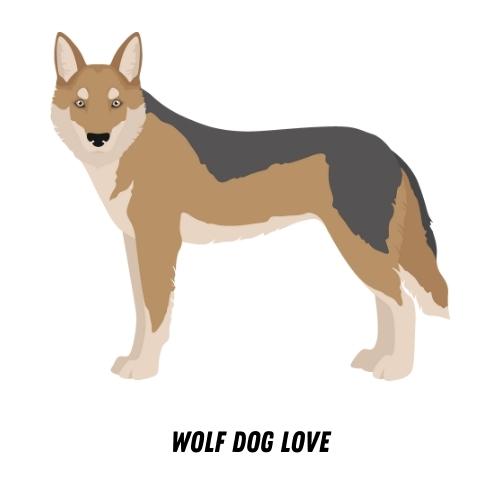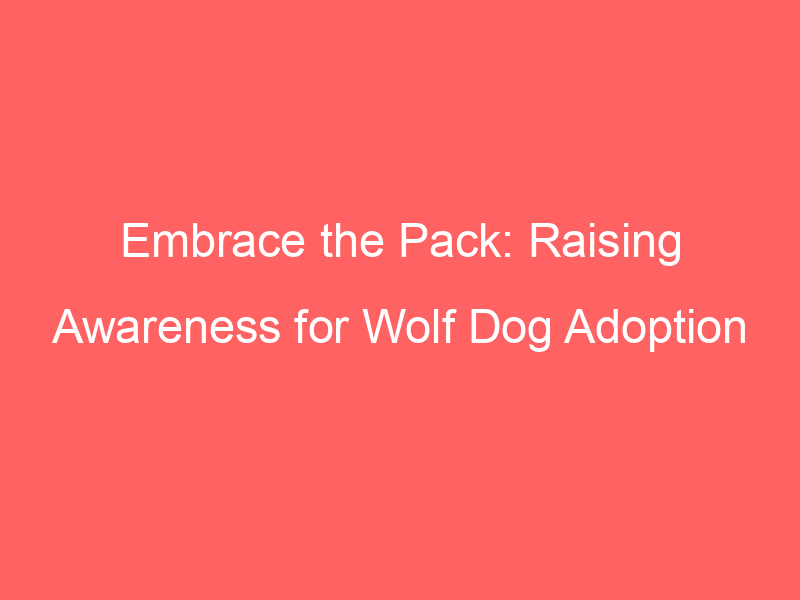Introduction to Wolf Dog Harmony
Have you ever wondered about the relationship between wolves and dogs? They share a common ancestry, but their lives are very different. In this blog post, we will explore the concept of wolf dog harmony and the importance of peaceful coexistence with these majestic creatures.
- Understanding the Concept of Wolf Dog Harmony
- Importance of Peaceful Coexistence with Wolf Dogs
- Respect for wildlife: Wolves are a vital part of our ecosystem. They help control the population of other animals and maintain the balance of nature. Respecting their space and their behaviors is a way of showing respect for wildlife.
- Preventing conflicts: Understanding wolf behavior can help prevent conflicts between wolves and dogs. For instance, knowing that wolves are territorial can help dog owners avoid areas where wolves might feel threatened.
- Improving our relationship with dogs: Understanding the natural behaviors of wolves can also help us understand our dogs better. After all, they share a common ancestry. This can lead to a more fulfilling and harmonious relationship with our pets.
Wolf dog harmony refers to the peaceful and balanced relationship between wolves, dogs, and humans. It’s about understanding and respecting the natural behaviors of both species. Wolves are wild animals, and dogs are domesticated pets. They have different needs and behaviors, but with the right understanding and approach, they can live in harmony.
For instance, wolves are pack animals. They live in groups and follow a strict hierarchy. Dogs, on the other hand, are used to living with humans. They are more adaptable and can adjust to different environments. Understanding these differences is the first step towards achieving wolf dog harmony.
Living peacefully with wolf dogs is not just about avoiding conflicts. It’s about respecting their natural behaviors and providing them with the right environment to thrive. This is important for several reasons:
In the following sections, we will delve deeper into the behavior of wolves and dogs, how to foster wolf dogs, and how to create a harmonious environment in pet homes. Stay tuned!
Understanding Wolf Dog Behavior
Wolf dogs are fascinating creatures that exhibit a unique blend of behaviors from both wolves and domestic dogs. Understanding their behavior is crucial for anyone considering adopting or fostering a wolf dog. In this section, we will delve into the basics of wolf dog behavior and debunk some common misconceptions.
Wolf Dog Behavior Basics
Wolf dogs are not like your typical domestic dogs. They possess a unique set of characteristics that set them apart. Let’s explore some of these key traits.
- Key characteristics of wolf dog behavior:
- Common misconceptions about wolf dogs:
Wolf dogs are highly intelligent and curious animals. They have a strong instinct to explore their surroundings and often require mental stimulation. They are also pack animals, meaning they thrive in a family setting and can form strong bonds with their human companions. However, they can also be territorial and may exhibit dominance behaviors. It’s important to remember that these behaviors can vary greatly depending on the individual animal and its specific wolf-to-dog ratio.
Many people believe that wolf dogs are aggressive or dangerous due to their wolf heritage. However, this is not necessarily true. While wolf dogs can exhibit certain behaviors associated with their wild ancestors, they are not inherently aggressive. In fact, many wolf dogs are shy and reserved, especially around strangers. Another common misconception is that wolf dogs are simply wolves that can be kept as pets. This is not the case. Wolf dogs are a distinct breed that combines traits from both wolves and domestic dogs.
Understanding wolf dog behavior is the first step towards fostering a harmonious relationship with these unique animals. In the next section, we will discuss effective training techniques for wolf dogs and the importance of consistency in training.
Training Wolf Dogs
Training a wolf dog is not like training a regular dog. It requires a unique approach and a deep understanding of their behavior. Let’s explore some effective training techniques and understand the importance of consistency in training.
- Effective Training Techniques for Wolf Dogs
Wolf dogs are intelligent and quick learners. However, they also have a strong will and can be independent. So, it’s important to use training techniques that work well with their nature. Here are a few techniques that have proven to be effective:
- Positive Reinforcement: Reward your wolf dog for good behavior. This can be a treat, a toy, or simply your affection. This encourages them to repeat the behavior.
- Consistent Commands: Use the same words for commands every time. This helps your wolf dog understand what you want from them.
- Patience: Training takes time. Don’t rush the process. Be patient and consistent.
- Understanding the Importance of Consistency in Training
Consistency is key when training wolf dogs. They need to understand what is expected of them, and this can only be achieved through consistent training. Here’s why consistency is important:
- Clear Communication: Consistent commands and actions help your wolf dog understand what you want. This leads to better communication between you and your pet.
- Building Trust: When you’re consistent, your wolf dog learns to trust you. They know what to expect and this helps build a strong bond.
- Effective Learning: Consistency helps your wolf dog learn faster. They understand the rules and can follow them more easily.
In conclusion, training a wolf dog requires patience, understanding, and consistency. With the right techniques and a consistent approach, you can train your wolf dog to be a well-behaved and loving pet.
Fostering Wolf Dogs
Wolf dogs are unique creatures, a mix of wild and domesticated traits. Fostering them requires understanding and patience. Let’s delve into creating a suitable environment for these majestic animals.
Creating a Suitable Environment
Creating a suitable environment for a wolf dog is crucial for their well-being. It involves providing essential elements in their home and ensuring a peaceful pet environment.
- Essential Elements of a Wolf Dog Home
- Creating a Peaceful Pet Environment
Wolf dogs need more than just a typical dog house. They require a large, secure outdoor space to roam and explore. This space should include a high fence to prevent them from escaping and causing harm. Shelter from the elements, like a sturdy dog house, is also important. Additionally, they need plenty of mental and physical stimulation. This can be achieved by providing toys, agility equipment, and regular exercise.
Wolf dogs are sensitive to their environment. A peaceful pet environment is free from constant loud noises and overcrowded spaces. It’s important to provide a calm, quiet space where your wolf dog can retreat and relax. Regular routines and minimal changes to their environment can also help reduce stress for wolf dogs.
Remember, fostering a wolf dog is a big responsibility. It requires time, patience, and understanding. But with the right environment and care, you can help your wolf dog live a happy, healthy life.
Wolf Dog Coexistence Tips
Living in harmony with wolf dogs is not an impossible task. With the right strategies and understanding, you can foster a peaceful coexistence with these majestic creatures. Here are some tips and a case study to guide you on this journey.
- Strategies for Peaceful Coexistence with Wolf Dogs
- Establish Boundaries: Wolf dogs are naturally territorial. Establish clear boundaries within your home to prevent conflicts.
- Provide Adequate Exercise: Wolf dogs are active animals. Regular exercise helps keep them healthy and reduces aggressive behavior.
- Consistent Training: Consistent and positive reinforcement training can help manage their behavior and promote peaceful coexistence.
- Proper Socialization: Introduce your wolf dog to different environments, people, and animals. This helps them become more adaptable and less aggressive.
- Case Study: Successful Wolf Dog Coexistence
Understanding the unique needs and behaviors of wolf dogs is the first step towards peaceful coexistence. Here are some strategies to help you:
Let’s look at a real-life example of successful coexistence with a wolf dog. Meet John and his wolf dog, Max.
| Name | Wolf Dog | Coexistence Strategy |
|---|---|---|
| John | Max | Regular exercise, consistent training, and socialization |
John adopted Max as a pup and understood the unique needs of a wolf dog. He established clear boundaries in his home, provided regular exercise, and used positive reinforcement training. He also introduced Max to various environments and people, helping him adapt better. Today, Max is a well-behaved and loved member of John’s family, living proof that peaceful coexistence with wolf dogs is possible.
Remember, every wolf dog is unique and may require different approaches. The key is patience, understanding, and love. With these, you can foster a harmonious relationship with your wolf dog.
Harmony in Pet Homes
Creating a harmonious environment in a home with multiple pets can be a challenge, especially when one of those pets is a wolf dog. However, with the right approach, it’s possible to integrate a wolf dog with other pets successfully.
Integrating Wolf Dogs with Other Pets
Integrating a wolf dog with other pets can be a complex process. It requires understanding the unique behaviors and needs of wolf dogs, as well as the dynamics of your existing pet family. Here, we’ll discuss the challenges you may face and provide solutions to help you overcome them.
- Challenges and solutions in integrating wolf dogs with other pets
- Key takeaways for successful integration
One of the biggest challenges in integrating wolf dogs with other pets is their instinctual prey drive. This can lead to conflicts with smaller pets. To mitigate this, it’s important to provide separate spaces for your pets and supervise their interactions closely. Training your wolf dog to obey commands can also help manage their behavior around other pets.
Successful integration of a wolf dog with other pets requires patience, understanding, and consistency. Here are some key takeaways:
| Key Takeaways |
|---|
| Understand the unique behaviors and needs of your wolf dog |
| Provide separate spaces for your pets |
| Supervise interactions between your pets closely |
| Train your wolf dog to obey commands |
Remember, every pet is unique and what works for one might not work for another. It’s important to be flexible and adapt your approach as needed. With time, patience, and the right strategies, you can create a harmonious pet home with a wolf dog.
Maintaining Harmony in Multi-Pet Homes
Living with multiple pets can be a joy, but it can also present challenges. The key to maintaining harmony in a multi-pet home lies in understanding each pet’s needs and behaviors, and finding ways to meet them without causing conflict. Here are some strategies and a case study to help you achieve this.
- Strategies for maintaining peace in homes with multiple pets
- Establish a routine: Pets thrive on routine. Feeding, playtime, and rest periods should occur at the same time every day. This helps to reduce anxiety and conflict.
- Provide separate spaces: Each pet should have its own space for sleeping and relaxing. This can help to reduce territorial disputes.
- Train your pets: Basic obedience training can help to prevent behavioral problems and conflicts. It’s especially important to train your pets to respond to commands like “leave it” and “stay”.
- Monitor interactions: Keep a close eye on your pets when they are together, especially in the beginning. If you see signs of aggression or fear, intervene immediately.
- Case study: Achieving harmony in a multi-pet home
There are several strategies you can use to maintain peace in a home with multiple pets. Here are some of the most effective ones:
Consider the case of the Smith family, who successfully integrated a wolf dog into their home with two cats and a small dog. They achieved harmony by using the strategies mentioned above.
| Strategy | How it was applied |
|---|---|
| Establish a routine | The family set specific times for feeding, play, and rest. This helped to reduce anxiety and conflict among the pets. |
| Provide separate spaces | Each pet had its own bed and relaxation area. This helped to prevent territorial disputes. |
| Train your pets | The wolf dog was trained to respond to commands like “leave it” and “stay”. This helped to prevent conflicts with the other pets. |
| Monitor interactions | The family closely monitored the pets when they were together and intervened if they saw signs of aggression or fear. |
By implementing these strategies, the Smith family was able to maintain peace and harmony in their multi-pet home.
Conclusion: The Peaceful Kingdom
In this final section, we will summarize the key points we have discussed about creating harmony in wolf dog homes. We will also share some final thoughts on the importance of understanding and fostering wolf dogs.
- Recap of Key Points on Creating Harmony in Wolf Dog Homes:
- Final Thoughts on the Importance of Understanding and Fostering Wolf Dogs:
Creating a peaceful kingdom for your wolf dog involves understanding their unique behaviors and needs. We’ve learned that wolf dogs are not like regular dogs; they have a strong pack mentality and require a leader. This means you, as the owner, must establish yourself as the pack leader. We also discussed the importance of exercise and mental stimulation for wolf dogs. A bored wolf dog can become destructive, so it’s essential to provide them with plenty of physical activity and mental challenges.
Understanding and fostering wolf dogs is not just about maintaining peace in your home. It’s about respecting these magnificent creatures for who they are. Wolf dogs are not pets to be owned but companions to be cherished. They require commitment, patience, and understanding. But the rewards of sharing your life with a wolf dog are immeasurable. They offer loyalty, companionship, and a unique bond that is unlike any other.
In conclusion, creating a peaceful kingdom for your wolf dog is achievable with the right knowledge and commitment. Remember, understanding your wolf dog’s behavior is the key to fostering a harmonious relationship. By doing so, you’re not just creating a peaceful home, but also contributing to the overall well-being of these wonderful animals.








